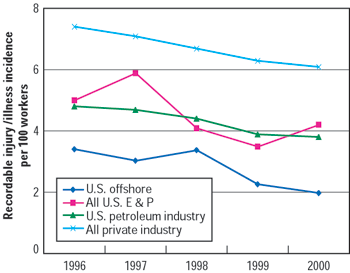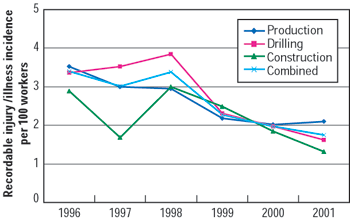Offshore Safety
Industry standards result in improved offshore safety
Frequently updated standards, improved technology, training and better communication lowered offshore illness/injury rates by 49%
Peter Velez, API Executive Committee on Drilling and Production Operations
Offshore oil and gas operations in the US are as remarkable for their safety as for their cutting-edge technology and vast production of energy. According to government statistics, it is safer to work on an offshore platform than in a real estate office, a photo studio, or a museum.
Indeed, the statistics show the offshore to be one of the safer workplaces in America. In 2000 – the latest year comparative data are available from the Minerals Management Service (MMS) and the Bureau of Labor Statistics – the offshore industry’s injury and illness rate was almost 68% lower than all of private industry and 48% less than the petroleum industry as a whole, Fig. 1.
 |
Fig. 1. In 2000, US offshore injury and illness rates were almost 68% lower than all private industry and 48% less than the petroleum industry as a whole. Source: BLS, MMS. (Note: The 2000 value on the US petroleum industry line includes all petroleum industry except oil pipelines and refining.)
|
|
The statistics also demonstrate that offshore is getting safer. The most recent offshore data from MMS show that the combined recordable injury and illness rates declined almost 49% between 1996 and 2001. Combined lost workday cases fell almost 66%, Fig. 2.
 |
Fig. 2. US offshore job-related injury and illness data by type of operation show a decline of almost 49% between 1996 and 2001. Lost workday cases fell almost 66%. Source: MMS.
|
|
Given the nature of offshore work, making it safe is significant. Flying helicopters, operating cranes, maneuvering supply boats and vessels moving in wind and weather carry significant risks. Companies have successfully managed these risks through comprehensive health, safety and environmental management programs, frequently updated safety standards and procedures, improved technology, ongoing training, better communication and a willingness to learn from mistakes. They have also leveraged their resources through trade association initiatives and worked closely with contractors and government regulators. In short, they have sought every means to enhance safety performance and made safety an integral part of their businesses.
Safety standards. API and industry standards and recommended practices (RPs) have played a key role making operations safer. Those for offshore production and drilling facilities cover the design, installation and/or implementation of various safety systems and procedures. Both MMS and the US Coast Guard have incorporated many of these standards into their regulations, as have various non-US government agencies.
Offshore standards and RPs are updated on an ongoing basis, both at regular intervals and whenever experience warns of a problem. For example, API is now revising RP2D on Operation and Maintenance of Offshore Cranes, following reports of wire rope failures. This will be the second revision of this standard in three years.
Improved technology. Advancing technology has transformed the offshore industry over the decades, expanding opportunities, boosting productivity, but also enhancing safety. Electronic systems allow remote operation and monitoring of equipment, which removes workers from proximity to potential hazards. Computers monitor thousands of operating checkpoints simultaneously and instantly flag any abnormal condition. Unmanned, remotely operated vehicles perform a wide range of offshore functions from site surveying to installation and maintenance of equipment, thereby avoiding much of the need for human presence in dangerous underwater environments, especially in deepwater.
Better communication. Communication has been critical to improving safety. There is now ongoing communication about safety within companies, between industry associations and their members and between government and industry. When MMS or the Coast Guard learn of accidents, they alert industry. When the International Association of Drilling Contractors (IADC) or API hears of safety problems from any source, they pass the information along to their members. Offshore companies keep personnel at all of their locations aware of problems at a single location. Thanks to today’s electronic communications, important information gets to all who need it quickly, often within minutes.
Safety management. Planning is essential to safety. Before new projects are undertaken or new equipment, procedures and personnel are employed, managers and workers consider risk potential and plan how to reduce it. They are guided by RP75, Recommended Practice for Development of a Safety and Environmental Management Program (SEMP) for Outer Continental Shelf Operations and Facilities. This recommended practice, which was issued in 1993, is a fit-for-purpose tool for integrating safety management into all offshore operations.
The first comprehensive safety and environmental management standard of its kind in the world, RP75 reflects the contributions of many offshore safety and operational experts with hundreds of years of experience in the oil and gas industry – government agencies, such as MMS and Coast Guard; and industry trade groups, including API, Offshore Operators Committee, National Ocean Industries Association, Independent Petroleum Association of America and IADC. The program was created to cover activities, procedures and operating hardware. It was designed to be flexible and responsive and to become a permanent part of a company’s culture, objectives and operations. Many offshore operators and contractors, including all API oil company members, have created safety and environmental management programs that follow RP75 recommendations.
A SEMP program starts with an assessment of operating and design requirements and a hazards analysis. It requires establishment of safe operating procedures, work practices, management-of-change procedures and associated training. It calls for procedures that ensure that the design, fabrication, installation, testing, inspection, monitoring and maintenance of equipment meet safe (minimum) standards. In addition, it recommends periodic auditing of safety programs – and requires emergency response and incident investigation to help mitigate harm and prevent future mistakes.
Evaluation of past performance is critical to continuous improvement in safety performance. Many offshore companies participate in MMS’s OCS Performance Measures Program, which calculates 20 annual, OCS-wide safety and environmental performance indices (such as injuries and illnesses, fires, well blowouts and oil spills). Compiling information for this program helps ensure that companies take a close look at their performance. The indices permit them to compare their performance with industry averages.
Safety regulations and oversight. Government oversight and regulation have also contributed to the industry’s safety performance. Operators must obtain numerous federal permits and comply with many sets of federal and state regulations to operate on the federal OCS, including the Gulf of Mexico. Agencies that regulate offshore companies include MMS and the Coast Guard along with other federal, state and local government entities. The industry has closely cooperated with government regulators to ensure that their rules are implemented in a way that encourages improved safety performance. In 2001, MMS conducted more than 16,000 facility inspections on the OCS.
Training and certification. A number of companies, including several offshore energy companies, conduct training. To ensure consistency and effectiveness, API is launching a Training Provider Certification Program. The API program will help enhance offshore employee safety performance by setting minimum standards for training providers in such areas as well completion, well workover, well servicing, and drilling and production safety systems. It will also cover training in crane operations and rigging not addressed by the former MMS certification program. For more information on the API program, which will cover all industry-related training, contact quality@api.org. 
THE AUTHOR
|
| |
P. K. (Peter) Velez is manager Regulatory Affairs and Incident Command for Shell Exploration and Production Co. He is active in trade association groups including: chairman of API’s Executive Committee on Drilling and Producing Operations, Offshore Operators Committee, NOIA's Environmental Committee and chairman of API's SEMP and Performance Measures Committee. He is past chairman of the USCG National Offshore Safety Advisory Committee. He is a member of the Board of Directors of the Marine Preservation Association and the Louisiana Mid-Continent Oil and Gas Association, and serves on the Executive Board of the Offshore Operators Committee. Mr. Velez has served on committees of the National Petroleum Council, National Academy of Sciences' Marine Board and other special Task Forces.
|
| |
|
|




